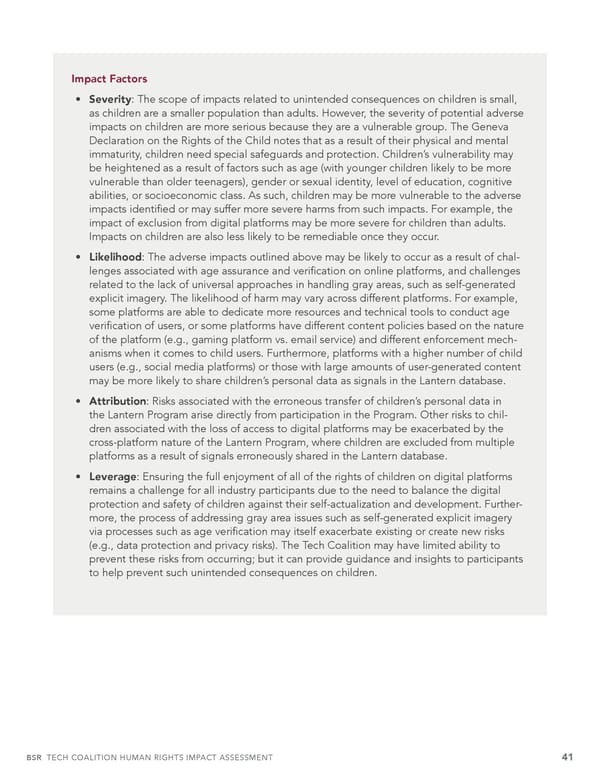Impact Factors • Severity: The scope of impacts related to unintended consequences on children is small, as children are a smaller population than adults. However, the severity of potential adverse impacts on children are more serious because they are a vulnerable group. The Geneva Declaration on the Rights of the Child notes that as a result of their physical and mental immaturity, children need special safeguards and protection. Children’s vulnerability may be heightened as a result of factors such as age (with younger children likely to be more vulnerable than older teenagers), gender or sexual identity, level of education, cognitive abilities, or socioeconomic class. As such, children may be more vulnerable to the adverse impacts identi昀椀ed or may suffer more severe harms from such impacts. For example, the impact of exclusion from digital platforms may be more severe for children than adults. Impacts on children are also less likely to be remediable once they occur. • Likelihood: The adverse impacts outlined above may be likely to occur as a result of chal- lenges associated with age assurance and veri昀椀cation on online platforms, and challenges related to the lack of universal approaches in handling gray areas, such as self-generated explicit imagery. The likelihood of harm may vary across different platforms. For example, some platforms are able to dedicate more resources and technical tools to conduct age veri昀椀cation of users, or some platforms have different content policies based on the nature of the platform (e.g., gaming platform vs. email service) and different enforcement mech- anisms when it comes to child users. Furthermore, platforms with a higher number of child users (e.g., social media platforms) or those with large amounts of user-generated content may be more likely to share children’s personal data as signals in the Lantern database. • Attribution: Risks associated with the erroneous transfer of children’s personal data in the Lantern Program arise directly from participation in the Program. Other risks to chil- dren associated with the loss of access to digital platforms may be exacerbated by the cross-platform nature of the Lantern Program, where children are excluded from multiple platforms as a result of signals erroneously shared in the Lantern database. • Leverage: Ensuring the full enjoyment of all of the rights of children on digital platforms remains a challenge for all industry participants due to the need to balance the digital protection and safety of children against their self-actualization and development. Further- more, the process of addressing gray area issues such as self-generated explicit imagery via processes such as age veri昀椀cation may itself exacerbate existing or create new risks (e.g., data protection and privacy risks). The Tech Coalition may have limited ability to prevent these risks from occurring; but it can provide guidance and insights to participants to help prevent such unintended consequences on children. BSR TECH COALITION HUMAN RIGHTS IMPACT ASSESSMENT 41
 Tech Coalition Human Rights Impact Assessment of the Lantern Program Page 40 Page 42
Tech Coalition Human Rights Impact Assessment of the Lantern Program Page 40 Page 42